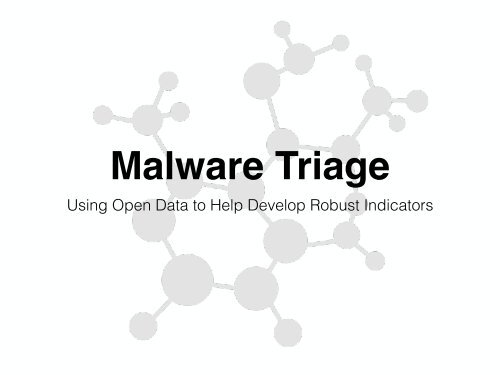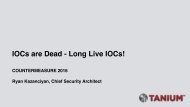Malware Triage
Malware-Triage-Using-Open-Data-to-Help-Develop-Robust-Indicators-Sergei-Frankoff-Sean%20Wilson
Malware-Triage-Using-Open-Data-to-Help-Develop-Robust-Indicators-Sergei-Frankoff-Sean%20Wilson
You also want an ePaper? Increase the reach of your titles
YUMPU automatically turns print PDFs into web optimized ePapers that Google loves.
<strong>Malware</strong> <strong>Triage</strong><br />
Using Open Data to Help Develop Robust Indicators
Hello, My name is:<br />
Sergei Frankoff<br />
sergei@openanalysis.net<br />
Sean Wilson<br />
sean@openanalysis.net
OPENANALYSIS.NET
What is an IOC<br />
Indicators of Compromise (IOCs) are<br />
forensic artifacts of an intrusion that can<br />
be identified on a host or network.<br />
openioc.org<br />
(http://openioc.org/resources/An_Introduction_to_OpenIOC.pdf)
IOC Formats<br />
We Aren’t Talking<br />
About Formats!
Traditional View of IOCs
In Practice…<br />
Is APTx attacking us? I saw<br />
this frightening article in CISO<br />
monthly magazine…<br />
WTF?? Ransomeware<br />
just infected half of<br />
accounting??<br />
Wait didn’t I just<br />
remove this same<br />
trojan from Dave’s<br />
workstation last week?<br />
Hey look I just<br />
hooked that IOC<br />
feed to our IDS…<br />
OMG! Our IDS just<br />
blocked traffic to all<br />
of our developers!
A Possible Solution: <strong>Triage</strong><br />
Suspicious<br />
URL<br />
Suspicious<br />
E-mail<br />
Is it<br />
malicious?<br />
What is it<br />
exploiting?<br />
Do we have<br />
exposure?<br />
Incident!<br />
Security<br />
Event<br />
Intel feed
A Better Solution:<br />
<strong>Triage</strong> + IOCs = Automation!<br />
Suspicious<br />
URL<br />
Suspicious<br />
E-mail<br />
Filter<br />
knowns<br />
Is it<br />
malicious?<br />
What is it<br />
exploiting?<br />
Do we have<br />
exposure?<br />
Incident!<br />
Security<br />
Event<br />
Intel feed<br />
IOCs<br />
Root cause<br />
analysis
IOCs Remove The Knowns<br />
And Reveal The Unknown<br />
Unknown<br />
Known Good<br />
Known Bad
The Problem With AV<br />
Artemis!1A5E05B1B9E1<br />
Artemis!262BC0AE2FB0<br />
Artemis!04296F13925B<br />
Artemis!110C43F8A337<br />
Artemis!9BFC61456261<br />
Artemis!9BE792AC4667
<strong>Malware</strong> Specific IOCs<br />
IOCs:<br />
Indicators of Compromise.<br />
<strong>Malware</strong> Specific IOCs:<br />
forensic artifacts resulting from the<br />
presence or execution of malware.<br />
AV Signatures
Robust IOCs<br />
Effectiveness of IOC<br />
Brittle IOC<br />
Robust IOC<br />
Diversity of<br />
<strong>Malware</strong><br />
Lifetime of <strong>Malware</strong> Family
Robust is not …<br />
One is the<br />
loneliest<br />
number : (
More Robust Is…<br />
Multiple Samples<br />
+<br />
Comparative<br />
Analysis!<br />
Reverse engineering<br />
with a Sandbox!
Most Robust Is…<br />
Multiple Samples<br />
+<br />
Code Review<br />
+<br />
Comparative<br />
Analysis!!<br />
Reverse engineering<br />
with IDA and a Debugger!!
The Key is Comparative Analysis<br />
Pivot<br />
(Attribute)<br />
Sample #2<br />
Primary<br />
Sample<br />
Sample #1<br />
This is one of the<br />
most important slides<br />
in the presentation.
Building Robust Indicators<br />
Analysis<br />
(<strong>Triage</strong>)<br />
Identify<br />
Pivots<br />
Discovery<br />
Mining Open<br />
Data<br />
Comparative<br />
Analysis<br />
Develop<br />
IOC<br />
Test<br />
(Validate)
Analysis <strong>Triage</strong><br />
Is it malicious?<br />
Can we identify the malware family?<br />
Collect static attributes<br />
Collect dynamic attributes
Is it Malicious / What is it?<br />
VS.<br />
Binarly
Static Attributes<br />
Hmm… Something isn’t right,<br />
there are no file properties for<br />
this executable?<br />
I’m totally legit!
Static Attributes: Metadata<br />
Compiler<br />
Artifacts<br />
Easily Modified<br />
Can make poor indicators<br />
EXIF Data<br />
Sample Discovery<br />
Can work as primary indicators
Static Attributes: Imports<br />
Compilation<br />
Library and<br />
API Imports<br />
Use Imphash!
Static Attributes: Strings<br />
Analysis with<br />
Context<br />
Analysis without<br />
Context
Try our free PE analysis<br />
tool PF<strong>Triage</strong>!
This file is packed! We aren’t<br />
going to get any useful static<br />
attributes.
Static Attributes Identified<br />
• Initial Sample was packed with UPX<br />
• Contains no file or version metadata
Packer / Crypter<br />
vs. Static Attributes<br />
Payload<br />
Packer<br />
Stub<br />
Obfuscated<br />
Payload<br />
Low Quality<br />
Static Attributes
Packer / Crypter Weakness:<br />
Runtime!<br />
A<br />
1<br />
A<br />
1<br />
X<br />
B<br />
C<br />
2<br />
3<br />
4<br />
5<br />
Windows API<br />
vs.<br />
X<br />
B<br />
C<br />
2<br />
3<br />
4<br />
5<br />
Windows API<br />
PE Runtime<br />
PE Runtime
Sandbox Magic<br />
Sandbox<br />
Process Monitor<br />
X<br />
A<br />
B<br />
C<br />
Windows API<br />
Network<br />
Filesystem<br />
Registry<br />
Process<br />
Services<br />
PE Runtime<br />
Synchronization
When Your Sandbox Doesn’t Work…<br />
Ghetto Runtime Analysis<br />
OR +
Dynamic Attributes<br />
In-Memory Strings<br />
Process Handles / Mutex<br />
Access / Created Files<br />
Registry Keys<br />
Network Traffic
Level Up! Your Analysis With<br />
Some Light Debugging<br />
Quickly trace the sample in a<br />
debugger to deobfuscate strings<br />
and gain CONTEXT.<br />
Try Windbg!
Dynamic Attributes Identified<br />
• Creates Mutex: QKitMan2016_1<br />
• Creates Registry Key: <br />
HKEY_CURRENT_USER\SOFTWARE\QKitMan2016<br />
• Requests IP from IPReq using HTTP GET Request<br />
• Post IP as Payload to LiveJournal account qkitman1010
Identify Pivots<br />
Collect your notes<br />
Choose best pivots<br />
Prepare to hunt
Rough Notes Are OK<br />
VS.
Discovery (Hunting)<br />
Searching for related samples<br />
Mining open data (the easy way)<br />
Acquiring samples
Mining Open Data<br />
virusshare.com
Tricks For Searching<br />
Online Sandboxes<br />
• Shared Virtualization<br />
Infrastructure<br />
• Shared Templates<br />
• Hunting using<br />
computed Values
Mining Open Data With OAPivot
Sample Acquisition<br />
Sandbox Shared Samples<br />
Sharing Services<br />
DFIR Lists and Trust groups
Sandbox Shared Samples<br />
Share your samples!
Sharing Services<br />
VirusShare
Comparative Analysis<br />
Identify common characteristics<br />
Common Properties<br />
Common Behaviour<br />
This is a key section<br />
even though there<br />
aren’t a lot of slides.
Comparison Checklist<br />
Initial Sample<br />
Pivot Sample A Pivot Sample B<br />
Strings X X<br />
Exif Data<br />
Imphash<br />
Memory<br />
Strings<br />
X X X<br />
Mutex X X<br />
File Names<br />
X<br />
Registry Keys X X X<br />
Network Traffic X X
Some network strings remain constant<br />
between all samples while others<br />
differ!
The mutex changes between samples<br />
but only slightly… maybe we can work<br />
with that.
Look at that! The same registry key for<br />
all samples… I remember that key from<br />
the STRINGS too!
Level Up! Your Comparative Analysis<br />
With Some Light Disassembly<br />
Comparative analysis works at the<br />
byte code level as well!
The opcodes of the string building<br />
algorithm are identical. Don’t forget to<br />
use wildcards for variable bytes (0D)!!
Develop IOC<br />
Choose IOC Format(s)<br />
Develop IOC
IOC Formats<br />
We Really Really<br />
There are tons of links to great free<br />
IOC training on our site : )<br />
Aren’t Talking About<br />
Formats!
Testing<br />
Test IOCs Against Known Bad<br />
Test IOCs Against Known Good<br />
Automate Discovery
Known Bad<br />
Run indicators<br />
against repository<br />
of known bad<br />
Update when<br />
required<br />
Validate!<br />
Indicator types dictate<br />
how they are tested.
Known Good<br />
Test indicator against<br />
a repository of known<br />
good samples<br />
Resolve<br />
Issues<br />
Validate!<br />
Try testing IOCs against your<br />
corporate “Golden image(s)”.
Monitor<br />
When indicators stop matching new<br />
samples something has changed!
Test Automation<br />
vs.<br />
Waiting for samples to hit<br />
you organization to test<br />
indicators<br />
Automating discovery<br />
before your organization<br />
is affected
Key Takeaways<br />
<strong>Triage</strong> + IOCs = Automation!<br />
Robust IOCs can be built without the need for a<br />
debugger or disassembly.<br />
Comparative analysis is key!<br />
Open data can be leveraged to collect related<br />
samples. Try OAPivot…<br />
Remember to continuously test your IOCs.
Try It Yourself<br />
http://bit.ly/2frHKg3<br />
763c7763a55b898b9618a23f85edfab6
Thank you : )<br />
And don’t forget… openanalysis.net
Image Attribution<br />
• Noun Project - Molecules by Zoë Austin<br />
• Noun Project - Funnel by Vaibhav Radhakrishnan<br />
• Noun Project - Shield by AFY Studio<br />
• Noun Project - Checklist by Arthur Shlain<br />
• Noun Project - Rocket Man by LuisPrado<br />
• Noun Project - Head-Desk by Karthik Srinivas<br />
• Noun Project - Checked Database by Arthur Slain<br />
• Noun Project - Kevin Augustine LO<br />
• Noun Project - Compilation by Richard Slater<br />
• Noun Project - Database Warning by ProSymbols<br />
• Noun Project - Flow Chart by Richard Schumann<br />
• Noun Project - Debug by Lemon Liu<br />
• Noun Project - Network by Creative Stall<br />
• Noun Project - File Settings by ProSymbols





